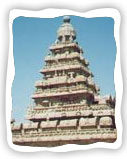 Mahabalipuram
MahabalipuramMahabalipuram
is the seaport of the ancient Palava dynasty of Kanci. The temples and
carvings here date back to the 7th century. They stand out because of their
simplicity and the fact that they also depict many scenes from the every-day
life of every-day people.
One of the most spectacular carvings is
the "Descent of the Ganges" also known as 'Arjuna's Penance'. The
carving tells the story of pious Arjuna who persuades Shiva to use his hair
to break the fall of the River Ganga. The large cleft between the boulders
is the where the Ganges descends. Around him is a crowd of animals, gods,
and ascetics watching the saving of the world as the river descends.
World famous for its shore temples, Mahabalipuram, was the second capital of
the Pallava kings of Kanchipuram. 58 kilometres from Madras on the Bay of
Bengal, this tiny sea side village of Mahabalipuram, is set in a boulder
strewn landscape. Tourists are drawn to this place by its miles of unspoiled
beach and rock-cut art. The sculpture of this place, is particularly
interesting, because it shows scenes of day-to- day life, in contrast to the
rest of the state of Tamil Nadu, where carvings generally depict gods and
goddesses.
As the early morning sun lifts the veil of darkness
from the city the whole city appears bathing in colors of orange and red.
The city in all its glory during early morning hours gives a mysterious
appearance. Undoubtedly, Mahabalipuram (or Mamallapuram, its ancient name)
is one of history's intriguing enigmas. The mystery of Mahabalipuram
lingers, unravelled, but its sculptural extravaganza is a living testament
of the virile artistic temperament of the Pallavas who were trend-setters in
South Indian art.
Mahabalipuram art is divided into four
categories : open air bas reliefs, structured temples, man-made caves and
rathas ('chariots' carved from single boulders, to resemble temples or
chariots used in temple processions). Most of the temples and rock carvings
of this place were built during the reigns of Narsinha Varman I (AD 630-668)
and Narsinha Varman II (AD 700-728). Though the initial kings of Pallava
dynasty were followers of Jainism, the conversion of Mahendra Varman (AD
600-630) to Shaivism led most of the monuments to be related with Shiva or
Vishnu.
 Tourist Attractions Arjuna's Penance
Tourist Attractions Arjuna's Penance
Carved in relief on the face of a huge rock, Arjuna's Penance is the
mythical story of the river Ganges, issuing from its source high in the
Himalayas. The surface of the rock has detailed carvings, showing the most
endearing and natural renditions of animals. It also shows deities, and
other semi-divine creatures and fables from the Panchtantra. Arjuna, one of
the Pandava brothers and a consummate archer, is shown standing on one leg,
doing penance to obtain a boon from Lord Shiva. It is said, that Arjuna had
made a journey to a bank, on the river Ganges to do penance, in the hope
that Shiva would part with his favourite weapon, the pashupatashatra, a
magic staff or arrow.
Mandapams (low rise, rockcut halls)
In all, there are eight mandapams scattered over the main hill, two of which
have been left unfinished.
Krishna Mandapam This is
one of the earliest rock-cut temples. It features carvings of a pastoral
scene, showing Lord Krishna lifting up the Govardhana mountain, to protect
his kinsmen from the wrath of Indra, the God of Rain.
Rathas
These are architectural prototypes of all Dravidian temples,
demonstrating the imposing gopurams and vimanas, multi-pillared halls and
sculptured walls, which dominate the landscape of Tamil Nadu. The rathas are
named after the Pandavas, the heroes of the Mahabharata epic. Although they
are widely known as "Five Rathas", there are actually eight of
them.
Shore Temples The shore temples were built in
7th century, during the reign of Rajasimha, and represent the final phase of
Pallava art. These beautiful and romantic temples, ravaged by wind and sea,
are so significant that they were given World Heritage listing, a few years
ago. The two spires of the temples, contain a shrine for Lord Vishnu, and
for Lord Shiva.
The Mahabalipuram dance festival, is held every
year from January 15 to February 15. During this period, dances from all
over the country are staged, here, including Kathakali from Kerala,
Kuchipudi from Andhra Pradesh, as well as tribal dances, puppet shows and
classical and traditional music concerts.








 Mahabalipuram
Mahabalipuram Tourist Attractions
Tourist Attractions